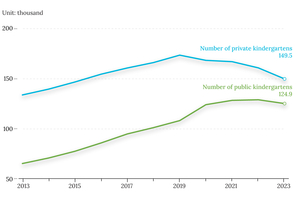Cover Story: School’s Out for China’s Rural Students as Classrooms Close
Listen to the full version

The once bustling main building of Xingshan Second Primary School in Hegang, a key coal mining city in China’s northeastern Heilongjiang province, now stands eerily quiet. Despite appearing relatively new from afar, up close it’s evident that disuse over time has taken its toll, with overgrown grass lining the empty schoolyard where children once played.
Instead of students, the school’s lone inhabitants are now an elderly couple, who serve as caretakers, passing their time by raising chickens and geese on the grounds. An occasional bark from one of the couple’s dogs punctuates the silence, echoing across the empty campus.

Download our app to receive breaking news alerts and read the news on the go.
Get our weekly free Must-Read newsletter.
- DIGEST HUB
- Many schools in former coal mining cities in China, such as Hegang, have closed due to declining student numbers following a government policy to reduce coal production from 2016, resulting in population outflows.
- The nationwide low birth rate, estimated at 1.0 births per woman, far below the 2.1 replacement level, has exacerbated school closures, with Heilongjiang and Jilin closing thousands of primary schools.
- Rural consolidation has led to the rise of large boarding schools in towns, posing challenges like inadequate amenities and the psychological impact on students.
The main building of Xingshan Second Primary School in Hegang, a former key coal mining city in China’s northeastern Heilongjiang province, now stands eerily quiet. Once bustling with youthful energy and hosting over 50 students per class, the school has been idle for eight years, its only inhabitants now an elderly couple raising chickens and geese [para. 1][para. 2][para. 3][para. 4]. This desolation is the unintended result of a 2016 policy aimed at reducing and consolidating coal production, which led to the closure of mines and the displacement of nearly 2 million people by 2020 [para. 5]. Consequently, Xingshan district's population halved, resulting in the closure of all four primary schools, leaving predominantly elderly residents behind [para. 5][para. 6].
This trend is not unique to Hegang. Nationwide outflows of people and a record low birth rate have led to a significant reduction in school-aged children in many former industrial cities and villages across northeast and central China. Experts predict a near 25% drop in the number of primary and middle school students within the next decade [para. 7][para. 8]. The drop in China’s total fertility rate, now about 1.0, far below the replacement level of 2.1, poses significant long-term economic risks [para. 8][para. 9]. Heilongjiang witnessed nearly 60% of its primary schools closing between 2013 and 2022, with neighboring provinces Jilin and Liaoning experiencing similar trends [para. 10].
To address the dwindling number of school-aged children, central and local governments are reconsidering educational resource allocation, especially in provinces like Heilongjiang and Jilin, which have been facing this issue for years. Some counties have very low birth rates, projecting that eventually only a single school will be needed to accommodate all the first-graders [para. 13][para. 14]. Estimates suggest a further decline of 18-20% in primary school student numbers in Heilongjiang and Jilin by 2027 and 11% in Liaoning [para. 15].
The reduction in student numbers requires consolidation of resources, leading to the development of boarding schools in urban centers to accommodate students from less populated rural areas [para. 19]. However, this shift poses challenges, such as potential psychological impacts on children separated from their families and the relocation of teachers, leading to unemployment concerns among educators [para. 21]. Some predictions suggest a surplus of nearly 1.3 million teachers by 2035 if no new hiring occurs [para. 22]. Several counties have already begun implementing optimization plans, leading to the closure of small schools and an increase in boarding school demand [para. 22]. Henan province, for instance, saw the closure of 456 smaller schools in 2023 [para. 24].
In efforts to manage the growing student population, boarding schools often lack essential amenities, such as showers, sports facilities, and medical clinics [para. 33][para. 34]. Surveys show that many boarding schools are under-equipped, exacerbating the problem [para. 33][para. 35].
While consolidating schools helps manage the reduced number of students, it also brings issues like bullying and marginalization of rural students in larger, urban schools [para. 40][para. 44]. This results in behavioral problems and a higher expulsion rate among relocated rural students [para. 48]. The challenge lies in balancing resource allocation while ensuring the well-being and growth of all students in this shifting educational landscape [para. 49].
- Beginning in 2016:
- The central government started a policy to reduce and consolidate coal production, resulting in a significant loss of jobs.
- 2013-2022:
- Nearly 60% of primary schools in Heilongjiang province, over 1,900 schools, were closed.
- By 2020:
- Nearly 2 million people lost their jobs due to coal production cutbacks.
- From 2021-2022:
- The school-age population was about 328 million.
- As of February 15, 2023:
- Fengping Primary School in Qianxi, Guizhou province, had only 30 students.
- In 2023:
- 456 smaller schools in Luoyang, Henan province, were shut down due to the policy of consolidating educational facilities.
- Since 2023:
- Some counties have implemented three-year optimization plans, leading to an increase in school consolidations and closures.
- May 17, 2023:
- A newly built primary boarding school was established in Rangtang County, Sichuan province.
- January 2024:
- A report by U.S.-based Peterson Institute for International Economics indicates China's total fertility rate is around 1.0.
- GALLERY
- PODCAST
- MOST POPULAR







 Sign in with Google
Sign in with Google
 Sign in with Facebook
Sign in with Facebook
 Sign in with 财新
Sign in with 财新